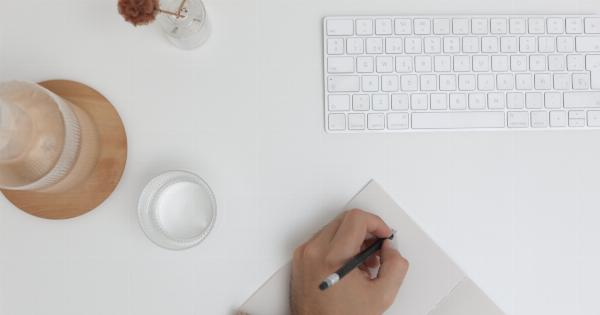Do you experience eye strain, dry eyes, or headaches after prolonged periods of screen time? Do you sometimes struggle to focus or have trouble falling asleep? These could all be signs of eye fatigue, which is a common symptom of modern day life.
However, there are plenty of quick and simple ways to help relax your eyes, relieve tension, and improve your visual health. Here are 30 ways to relax your eyes in 60 seconds!.
1. Palming
Palming is a simple yet effective way of relaxing eyes. Sit down, rub your hands together to create heat, and then place your warm hands over your eyes for 60 seconds. The darkness and warmth will help soothe your eyes and reduce fatigue.
2. Blinking
Blinking is an important reflex action that keeps eyes moist and clean, but we tend to blink less frequently when staring at screens. So, take a moment to blink several times in succession to lubricate your eyes and reduce strain.
3. Eye Stretching
Eye stretching is another simple way to relax eyes and improve circulation. Look upward as far as possible, then downward. Repeat the process several times and then look at the left and right. It helps reduce tension in the eye muscles.
4. Eye Massage
An eye massage can help to relieve tension in the eye muscles. Use your index and middle fingers to massage by rubbing small circles gently around your eye sockets for about 30 seconds.
5. Focusing Far
Looking into the distance can relax eye muscles and help refocus your eyes naturally. Try looking at an object that is far away from you, like a cloud or the horizon, for about half a minute.
6. Focusing Near
Focusing near can be equally beneficial, like looking at your hand. Count the wrinkles on the knuckles and then move your focus to the further edge of your hand and repeat. This activity can also be performed while looking at text manual.
7. Eye Rolling
Eye rolling can strengthen the eye muscles and relieve tensed muscles. Roll your eyes slowly clockwise and then anti-clockwise for a few seconds, and then blink before repeating the process four times for 15 seconds each time.
8. Mindful Healing
Above all relaxation techniques, it’s important to occasionally give your eyes the opportunity to rest. Take a moment to sit or lie down and practice mindful breathing, visualizing a peaceful scene, or simply focusing on your relaxation for one minute.
9. Take a Break
If you’re staring at a screen all day, it’s important to take frequent breaks. Try to have a break after every 20 minutes. Stand up, stretch your legs or take a breath of fresh air.
10. Adjust your Environment
Eye strain can also be caused by environmental factors, such as lighting and glare. Position your screen to avoid reflections, and adjust your brightness setting to match your surroundings.
Use a screen protector to filter out harsh blue light emitted by screens.
11. Use a Better Screen
If possible, try to invest in a screen with higher resolution. It will reduce the amount of effort needed to focus on text and graphics, reducing eye strain, and improving overall visual clarity.
12. Practice the 20-20-20 Rule
The 20-20-20 rule is simple and easy to remember. Every 20 minutes, look at an object 20 feet away for 20 seconds. This helps to reduce eye strain and keeps your eyes relaxed and comfortable.
Try setting a reminder on your phone to help you remember to do this.
13. Keep a Good Distance
Be sure that your computer screen, tablet or phone is at about arm’s length from your eyes. That way, you can read text on your screen with ease without having to strain your eyes.
Also, be sure that your computer screen or phone is placed at an appropriate height, so that your neck and back does not become stiff.
14. Use Good Lighting
If you’re straining to see what’s on your screen, it could be a sign that you need better lighting. Work in a well-lit room, and avoid bright lights or glare that could cause eye fatigue.
Use lamps to improve lighting conditions, and try to place your screen away from harsh light.
15. Adjust Text Size
If you’re struggling to read, you may need to adjust the size of the text on your screen. Too small font can cause eye fatigue, so adjust it to a comfortable size for your eyes.
16. Use Good Posture
Having good posture means having the right amount of strain on your body. To avoid eye straining, use a comfortable chair or adjust your chair so you can work comfortably.
Rest your feet on the floor by making sure your knees are in a comfortable position.
17. Try Eye Drops
If your work involves prolonged screen time, your eyes could go dry. Consider using eye lubricants that can keep the eyes moist and fresh.
18. Use Anti-Glare Glasses
Anti-glare glasses that are designed specifically for screen use can provide eye strain relief. They reduce glare by selectively blocking out white light, leaving the screen image crisp and clear.
19. Do Eye Yoga
Eye yoga exercise is a group of exercises targeted to relax your eyes, improve circulation and tone up eye muscles. Some simple eye yoga exercise include: rubbing palms, Zooming, Moving, and Shifting.
20. Do Shavasana
Shavasana is a simple yet effective relaxation pose. Lay down in a supine manner and close your eyes. Take deep breaths and just focus on your breathing pattern.
This helps to re-energize your eyes and the whole body by increasing blood circulation to your eye muscles.
21. The Pen Exercise
The pen exercise is a quick exercise that needs a pen or pencil and may reduce eye strain. Hold up the pen in front of your face. Then, move it slowly towards your nose, and hold this position for a few seconds.
Continue this process several times with little breaks in between to avoid eye fatigue.
22. Visual Meditation
Visual meditation can be performed anywhere and anytime, to help relax your eyes. Focus on a peaceful image with your eyes closed, and take long deep breaths.
23. Focus Shifting
Focus shifting is an exercise that targets eye muscles flexibility by shifting focus from near to far. Hold a pen up to your nose and move it far away while keeping your focus on it.
24. Squeeze and Release
This exercise keeps your eye muscles relaxed and strengthens them. Rub your hands together until they warm up. Close your eyes and place your palms on your eyes. Lightly squeeze them for just a second or two and release them. Do it three to five times.
25. Do Blink Drills
Staring at screens for prolonged periods hinders blinking, which is important in keeping eyes moisturized. Do a few blink drills to ensure you are blinking effectively. Blink fast, blink in slow motion, or double blink alternately for 30 seconds each.
26. Focus on Your Breath
Focusing on your breath allows your mind and eye to relax. Take a deep breath for 4 seconds and exhale for 6 seconds. Repeat the process for 60 seconds.
27. Do a Scalp Massage
Massage is a great way to help relax your eye muscles, but also your scalp muscles, which contributes to eye fatigue. Massage your scalp for about half a minute while taking long deep breaths.
28. Try Cranial Sacral Therapy
Cranial sacral therapy is a gentle technique for body treatment that targets the head. Applying mild pressure to the head bones, especially at the sides, can unblock the cranial bones and lead to eye tension’s easing.
29. Acupressure
Acupressure is a traditional Chinese technique that targets acu-points around the head and neck. Massaging acu-points around the eyes, forehead and temples can help reduce eye strain.
30. Re-frame Your Vision
Changing your vision can reduce eye strain and help boost creativity. Take a moment to observe something with your eyes in a different way than you’re used to. This can include changing the view angle or focus.





























